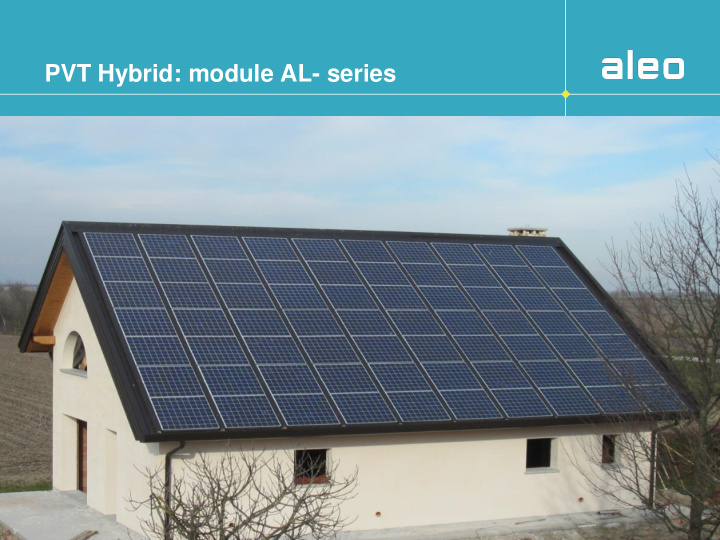



PVT Hybrid: module AL- series ak440, 22.01.2013, V1 1
PVT Hybrid, the combined sollution PHOTOVOLTAIC + THERMAL 2
What is the PVT module Is an hybrid technology based on simultaneous production of : Electrical energy from a photovoltaic module + Thermal energy by cooling down cristalline cells 3
Conventional photovoltaic modules STC CONDITION T = 25 ° C I = 1000 W/m 2 REAL EUROPEAN CONDITION T > 40 ° C I = 1000 W/m 2 4
PVT increase electrical efficiency of conventional photovoltaic modules 5
PVT increase overall energy efficiency of conventional modules 6
Electrical Data 7
PVT Main features ♦ Hybrid PVT modules have the same dimensions of the reference photovoltaic modules (e.g. FTXXXAL is based on Aleo Solar S_79 black line) and they can be used in all combinations with the photovoltaic ones. SAME THICKNESS STANDARD MC4 CONNECTORS 8
PVT module electrical specification PVT modules have same current of aleo S79 series PVT modules have same voltage output of aleo S79 series but according to working temperature of heat recovery it can be diferrent from standard configuration at NOCT PVT modules can be used in series with standard aleo S79 ( if not all the thermal power is needed) on the same MPPT tracker All voltages are additive so also if a module is « differently cooled» the result in voltage/power will be proportional on the string to average temperature of the single module Current of the module is directly related to irradiance and not appreciably affected by temperature 9
PVT module thermal specification The thermal power of the module is additive (916 W th) and they can be connected in series and parallel to reach desired global power Max reccomended number of modules in series is 4 optimal, 3-4 in series (nominal pressure drop is around 0,1 bar for each module, so max 0,4 bar for fluid circulation Standard flow rate is 2-2,5 l/min Hydraylical connections are in ½ inch brass material Standard pressure of hydraylical circuit is 1,5-2 bar (max pressure of modules is 6 bar) For piping can be used : copper , multilayer pipes with 90 ° C of max T specification , stainless steel Longer durability of high quality materials used (copper) in a stronger technical solution Reduced maintenance to hydraulic circuit due to lower maximum T 10
PVT module thermal specification Max temperature that can be reached is 90-92 ° C, no problem with boiling point and no damages at stagnation. System with forced circulation of fluid Typical hot water production ratio 70 l/m² in a day (in winter @ 20 -30 ° C – in summer @ 50-80 ° C) Pay attention to heat exchanger into the tank : High surface is needed (external plate heat exchanger is prefferable) The optimal surface for heating swimming pool is 60% of pool surface Mounting system is the same as in pv module External temperature probe, for measuring max T that the module can reach, for differential T controller regulation PVT cooling-thermal circuit is compatible with all standard antifreeze mixtures and can work with : • Glycol-based antifreeze mixtures family (ethylene or propylene glycol) • Our property antifreeze mixture (based on ethanol: less energy losses due to low viscosity, no toxicity, better for environment) 11
PVT module main advantages Increased electrical performance Longer durability (materials work at low T) Perfect aestetical and functional integration of two technologys : PV + TH Lower mounting structures and mounting time No stagnation effects, no corrosion at max T Defrost capablity Lower costs for integrated technology Lower manitenance Better environment (no toxicity, lower footprint) 12
PVT application PVT plant : 9,50kWp Module : FT_250AL Architectural integration 13
PVT application PVT plant : 3,30kWp Module : FT_165Ph Architectural integration 14
PVT application Public and private swimming pools (electricity + heating ) Generating hot water + electricity for residential/commercial buildings (hospitals, sport buildings, private houses, hotels etc) In combination with heat pumps (new Aleo-Fototherm kit) ground floor heating for residential, commercial buildings Ground floor heating for agricultural buildings (pigs, chickens) Greenhouses for hydroponic growing of vegetables Generating hot water + electricity for several industrial processes (juices production, milk pasteurization treatment, cheese production, textiles etc) Car washing plants, laundry shops 15
Recommend
More recommend